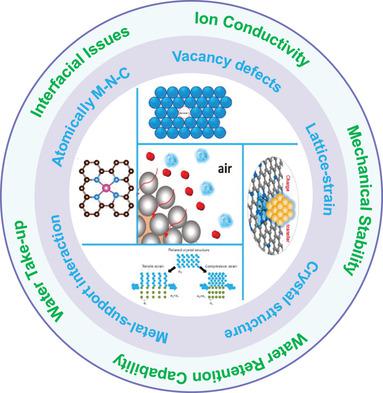当前位置:
X-MOL 学术
›
Small Methods
›
论文详情
Our official English website, www.x-mol.net, welcomes your
feedback! (Note: you will need to create a separate account there.)
Defect Electrocatalysts and Alkaline Electrolyte Membranes in Solid‐State Zinc–Air Batteries: Recent Advances, Challenges, and Future Perspectives
Small Methods ( IF 10.7 ) Pub Date : 2020-12-06 , DOI: 10.1002/smtd.202000868 Mingjie Wu 1 , Gaixia Zhang 1 , Lei Du 1 , Dachi Yang 2 , Huaming Yang 3 , Shuhui Sun 1
Small Methods ( IF 10.7 ) Pub Date : 2020-12-06 , DOI: 10.1002/smtd.202000868 Mingjie Wu 1 , Gaixia Zhang 1 , Lei Du 1 , Dachi Yang 2 , Huaming Yang 3 , Shuhui Sun 1
Affiliation

|
Rechargeable zinc–air batteries (ZABs) have attracted much attention due to their promising capability for offering high energy density while maintaining a long operational lifetime. One of the biggest challenges in developing all‐solid‐state ZABs is to design suitable bifunctional air‐electrodes, which can efficiently catalyze the key oxygen reduction reaction (ORR)/oxygen evolution reaction (OER) electrochemical processes. The other one is to develop robust electrolyte membranes with high ionic conductivity and superb water retention capability. In this review, an in‐depth discussion of the challenges, mechanisms, and design strategies for the defect electrocatalyst and the electrolyte membrane in all‐solid‐state ZABs will be offered. In particular, the crucial defect engineering strategies to tune the ORR/OER catalysts are summarized, including direct controllable strategies: 1) atomically dispersed metal sites control, 2) vacancy defects control, and 3) lattice‐strain control, and the indirect strategies: 4) crystallographic structure control and 5) metal–carbon support interaction control. Moreover, the most recent progress in designing electrolyte membranes, including polyvinyl alcohol‐based membranes and gel polymer electrolyte membranes, is presented. Finally, the perspectives are proposed for rational design and fabrication of the desired air electrode and electrolyte membrane to improve the performance and prolong the lifetime of all‐solid‐state ZABs.
中文翻译:

固态锌空气电池中的缺陷电催化剂和碱性电解质膜:最新进展、挑战和未来展望
可充电锌-空气电池(ZAB)因其在保持长使用寿命的同时提供高能量密度的有前途的能力而备受关注。开发全固态 ZAB 的最大挑战之一是设计合适的双功能空气电极,它可以有效地催化关键的氧还原反应(ORR)/析氧反应(OER)电化学过程。另一个是开发具有高离子电导率和极好的保水能力的坚固电解质膜。在这篇综述中,将深入讨论全固态 ZAB 中缺陷电催化剂和电解质膜的挑战、机制和设计策略。特别是,总结了调节 ORR/OER 催化剂的关键缺陷工程策略,包括直接可控策略:1) 原子分散的金属位点控制,2) 空位缺陷控制,和 3) 晶格应变控制,以及间接策略:4) 晶体结构控制和 5) 金属-碳载体相互作用控制。此外,还介绍了电解质膜设计的最新进展,包括基于聚乙烯醇的膜和凝胶聚合物电解质膜。最后,提出了合理设计和制造所需空气电极和电解质膜的观点,以提高全固态 ZAB 的性能并延长其寿命。4) 晶体结构控制和 5) 金属-碳载体相互作用控制。此外,还介绍了电解质膜设计的最新进展,包括基于聚乙烯醇的膜和凝胶聚合物电解质膜。最后,提出了合理设计和制造所需空气电极和电解质膜的观点,以提高全固态 ZAB 的性能并延长其寿命。4) 晶体结构控制和 5) 金属-碳载体相互作用控制。此外,还介绍了电解质膜设计的最新进展,包括基于聚乙烯醇的膜和凝胶聚合物电解质膜。最后,提出了合理设计和制造所需空气电极和电解质膜的观点,以提高全固态 ZAB 的性能并延长其寿命。
更新日期:2021-01-04
中文翻译:

固态锌空气电池中的缺陷电催化剂和碱性电解质膜:最新进展、挑战和未来展望
可充电锌-空气电池(ZAB)因其在保持长使用寿命的同时提供高能量密度的有前途的能力而备受关注。开发全固态 ZAB 的最大挑战之一是设计合适的双功能空气电极,它可以有效地催化关键的氧还原反应(ORR)/析氧反应(OER)电化学过程。另一个是开发具有高离子电导率和极好的保水能力的坚固电解质膜。在这篇综述中,将深入讨论全固态 ZAB 中缺陷电催化剂和电解质膜的挑战、机制和设计策略。特别是,总结了调节 ORR/OER 催化剂的关键缺陷工程策略,包括直接可控策略:1) 原子分散的金属位点控制,2) 空位缺陷控制,和 3) 晶格应变控制,以及间接策略:4) 晶体结构控制和 5) 金属-碳载体相互作用控制。此外,还介绍了电解质膜设计的最新进展,包括基于聚乙烯醇的膜和凝胶聚合物电解质膜。最后,提出了合理设计和制造所需空气电极和电解质膜的观点,以提高全固态 ZAB 的性能并延长其寿命。4) 晶体结构控制和 5) 金属-碳载体相互作用控制。此外,还介绍了电解质膜设计的最新进展,包括基于聚乙烯醇的膜和凝胶聚合物电解质膜。最后,提出了合理设计和制造所需空气电极和电解质膜的观点,以提高全固态 ZAB 的性能并延长其寿命。4) 晶体结构控制和 5) 金属-碳载体相互作用控制。此外,还介绍了电解质膜设计的最新进展,包括基于聚乙烯醇的膜和凝胶聚合物电解质膜。最后,提出了合理设计和制造所需空气电极和电解质膜的观点,以提高全固态 ZAB 的性能并延长其寿命。











































 京公网安备 11010802027423号
京公网安备 11010802027423号